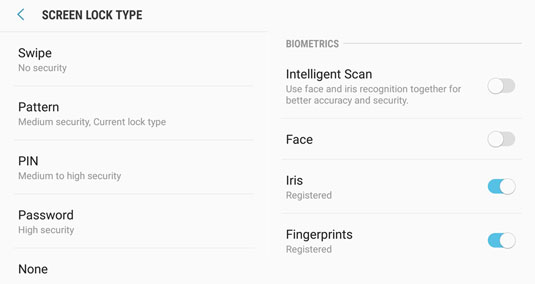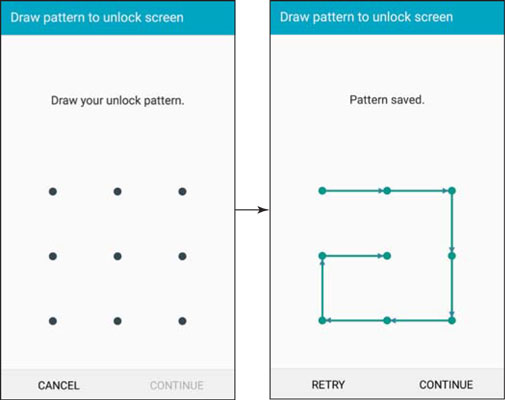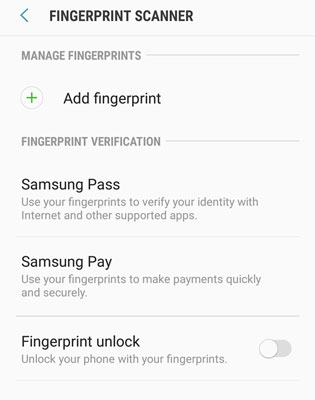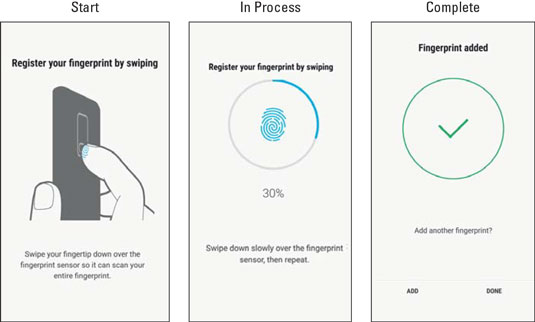- Unlock with a simple swipe across the screen.
- Unlock with a pattern that you swipe on the screen.
- Unlock with a PIN.
- Unlock with facial recognition.
- Unlock with a password.
- Unlock with your fingerprint.
- Unlock with an iris scan.
- Unlock with a combination of facial recognition and iris scan.
- Encrypt the data on your SD card.
If you want to choose one of the first six options, here’s what you do:
1. Tap the Settings icon.
This should be old hat by now.
2. Tap the Lock Screen and Security link. The Lock Screen and Security options.
The Lock Screen and Security options.This brings up the options seen here. You set some of the options mentioned in the preceding list and others when you follow the next instruction. This can be a little confusing.
3. Tap the Screen Lock Type link.This brings up the options seen here. Each option prompts you through what it needs before establishing your security selection.
 The Screen Lock options.
The Screen Lock options.For reasons that sort of make sense, your phone uses some terminology that can be confusing. To clarify, the term Screen Lock is an option you can select to prevent unauthorized users from getting into your phone. The term Lock Screen is short for the action of locking your screen or enabling the Screen Lock option.
Screen Lock options
Regardless of what screen lock you choose, have the following choices at hand:- An unlock pattern
- A PIN
- A password
- Your fingerprint
- Your face
- Your eyes
How to selecting among the Screen Lock options
The first option, unlocking your phone with a swipe, fools exactly no one and doesn’t slow anyone down. Rather than just having the Home screen appear, your phone tells you to swipe your finger on the screen to get to the Home screen. This is about as secure as waving at intruders and tossing them your phone, wallet, and keys. Let’s keep going.Draw out a pattern as the minimum screen-lock option. This is quick and easy. Tap the Pattern option on the screen seen here to get started. The phone asks you to enter your pattern and then asks you to enter it again. It then asks you to enter a PIN in case you forget your pattern.
 The unlock patterns: the blank screen and a sample pattern.
The unlock patterns: the blank screen and a sample pattern.The unlock pattern is a design that you draw with your finger on a nine-dot screen, as shown.
The image on the right happens to include all nine dots. You do not need to use all the dots. The minimum number of dots you must touch is four. The upper limit is nine because you can touch each dot only once. As long as you can remember your pattern, feel free to be creative.
Be sure to use a PIN you can remember a long time from now. You need this PIN only if you forget your pattern. That is a very rare situation for most people.
The next two options on the Screen Lock screen, PIN and Password, are more secure, but only as long as you avoid the obvious choices. If you insist upon using the PIN “0000” or “1111” or the word “password” as your password, don’t waste your time. It’s standard operating procedure within the typical den of thieves to try these sequences first. That’s because so many people use these obvious choices.If, someday, you forget your pattern, your PIN, or your password, the only option is to do a complete reset of your phone back to original factory settings. In such a case, all your texts and stored files will be lost. Try to avoid this fate: Remember your pattern, PIN, or password.
How to enter your fingerprints
Using your fingerprint to unlock your phone is very convenient. After you have entered your, you can set it up so that you simply put your finger on the fingerprint button, and your phone will open up to your home page.There are a few hoops you need to make this happen. You need to give your phone enough views of the finger you will use, which can be whichever finger you like, so that it is sure that it is you. It also wants to make sure that you, and only you, have stored a fingerprint. Your phone can store multiple fingers, and you do not want to have any shenanigans going on here, like someone slipping in her fingerprint on to your phone. To prevent this from happening, you need to select a security option — again a pattern, PIN, or password — to access the fingerprint screen.
If you want to access your phone using a fingerprint, here’s what you do:
1. Tap the Fingerprints Scanner in the Lock Screen and Security page.
This will bring up the image seen here.
 The Fingerprint Security Options screen.
The Fingerprint Security Options screen.2. Enter your pattern.
This is the same pattern you used for the Home screen. When you have done this, the screen seen on the left here appears.
 The Fingerprints registration screen.
The Fingerprints registration screen.3. Tap the Add Fingerprint option.
The leftmost screen shown here appears.
4. Press and hold lightly the Home button repeatedly.Keep tapping the fingerprint sensor on the rear of the phone just under the camera lens until you reach 100 percent. The gray circle in the middle of the screen will eventually turn completely blue, and then you get a congratulations screen on the right letting you know that you are at 100 percent.
Enjoy this keen sense of accomplishment, because in a moment, you will be returned to a screen like the one shown previously.
5. Switch the Fingerprint unlock switch to the On position.Your fingerprint is now in memory and ready to let you get to your home page with a quick swipe. Give it a try. It is very slick!
Entering your face and/or iris
Facial recognition and the iris scan are even easier! From the Lockscreen and Security page, tap either Facial Recognition or Iris Scan. You’ll be prompted to hold the phone toward your face. These recognition screens are shown here. They work remarkably fast. The facial recognition and iris scan screens for Mona Lisa.
The facial recognition and iris scan screens for Mona Lisa.The iris scan can struggle with contacts or glasses. Perhaps this can be your motivation to finally get Lasik eye surgery. Or, you can just use another, less convenient security method.
When your phone has your face or iris in its memory, all you need to do is hold up your phone when prompted, and it’ll know that it’s you!





